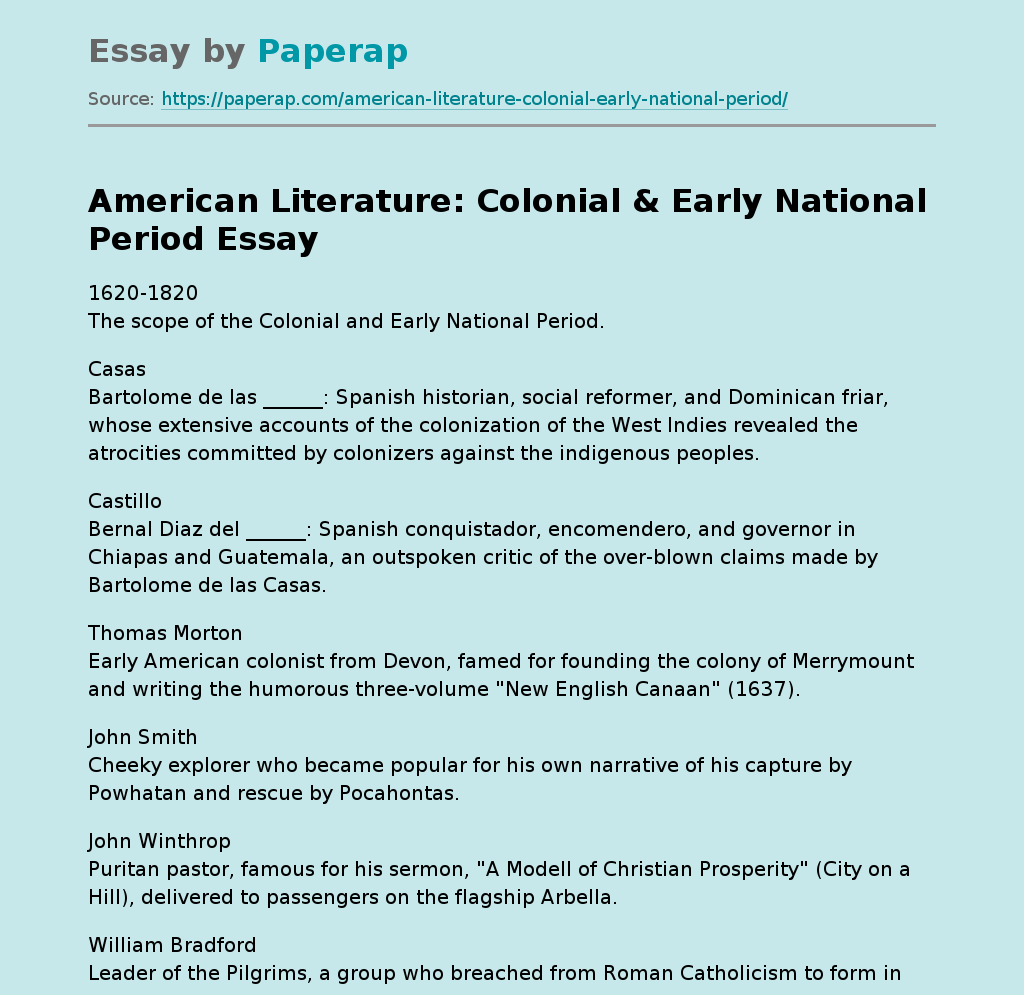American Literature: Colonial & Early National Period
Essay,
Pages 3 (645 words)
Views
72
1620-1820
The scope of the Colonial and Early National Period.
Casas
Bartolome de las ______: Spanish historian, social reformer, and Dominican friar, whose extensive accounts of the colonization of the West Indies revealed the atrocities committed by colonizers against the indigenous peoples.
Castillo
Bernal Diaz del ______: Spanish conquistador, encomendero, and governor in Chiapas and Guatemala, an outspoken critic of the over-blown claims made by Bartolome de las Casas.
Thomas Morton
Early American colonist from Devon, famed for founding the colony of Merrymount and writing the humorous three-volume “New English Canaan” (1637).
John Smith
Cheeky explorer who became popular for his own narrative of his capture by Powhatan and rescue by Pocahontas.
John Winthrop
Puritan pastor, famous for his sermon, “A Modell of Christian Prosperity” (City on a Hill), delivered to passengers on the flagship Arbella.
William Bradford
Leader of the Pilgrims, a group who breached from Roman Catholicism to form independent churches. Wrote “Of Plymouth Plantation”, a definitive work detailing the Pilgrims’ adventures.
Anne Bradstreet
Her collection of poems, “The Tenth Muse Lately Sprung Up in America” (1650), reveals her love for her husband, devotion to her family, and observations of colonial life.
Mary Rowlandson
Captured by the Wampanoag Indians during King Philip’s War, her account of captivity was published in 1682 and became the most popular American text in the 17th century.
Samuel Sewall
Judge, businessman, and printer. Best known for his involvement in the Salem Witch Trials.
Wrote the essay “The Selling of Joseph” (1700) which criticized slavery.
Cotton Mather
Known for his history of Christianity in New England, “Magnalia Christi Americana” (1702), and for his heavy involvement in the Salem Witch Trials.
Jonathan Edwards
The most widely anthologized preacher of colonial America. The classic “fire and brimstone” preacher, his most famous sermon was “Sinners in the Hands of an Angry God” (1741).
Benjamin Franklin
Took twenty years to write his autobiography. Created the humorous character Silence Dogood, who escapades were published in his brother’s magazine when he was still a teenager. Strove to reach “Moral Perfection.”
Samson Occum
The first Native American to publish his writings in English. One of the foremost missionaries, together with John Eliot, to cross-fertilize Native American communities with Christianized European culture.
Crevecoeur
J. Hector St. John de ______: Wrote “Letters from an American Farmer” which was highly successful in both England and France.
Equiano
Olaudah _____: His autobiography was the defining account of the life of a slave before Douglass’s.
Phillis Wheatley
A young, black slave, her first book of poems, “Poems on Various Subjects, Religions, and Morals” (1773) was published before she was 20 and a letter of authentication had to be attached to the manuscript to prove she had written it.
Susanna Rowson
Published “Charlotte Temple” (1791) which became the first American best-selling novel.
William Hill Brown
Wrote the first American novel, “The Power of Sympathy” (1789).
Washington Irving
The first American international superstar. “The Sketch Book of Geoffrey Crayon” housed his most mythologized stories, “The Legend of Sleepy Hollow” and “Rip Van Winkle.”
Rip Van Winkle
The first American story.
Catharine Maria Sedgwick
American novelist of “domestic fiction,” she promoted Republican motherhood. Wrote “Married or Single” (1857) which put forth the idea that women should not marry if it meant compromising their self-respect.
James Fenimore Cooper
Best known for his Leatherstocking series, five novels in which he reveals the underbelly of American nationalism. Most famous in the series is “The Last of the Mohicans” (1826). Wrote one of the first historical romances of the American Revolution, “The Spy” (1821), to prove to his wife he could write as well as his English contemporaries.
The Bread and Cheese Club
A literary society founded in part by James Fenimore Cooper, which housed romantic painters of the Hudson River School and even William Cullen Bryant.
William Apess
Ordained Methodist minister, writer, and activist of mixed Pequot descent, a leader in Massachusetts. His autobiography was among the first published by a Native American writer
American Literature: Colonial & Early National Period. (2019, Jan 30). Retrieved from https://paperap.com/american-literature-colonial-early-national-period/

